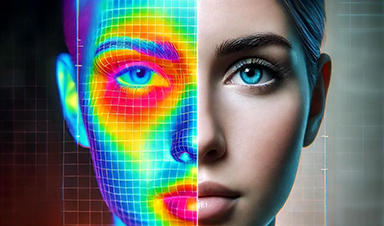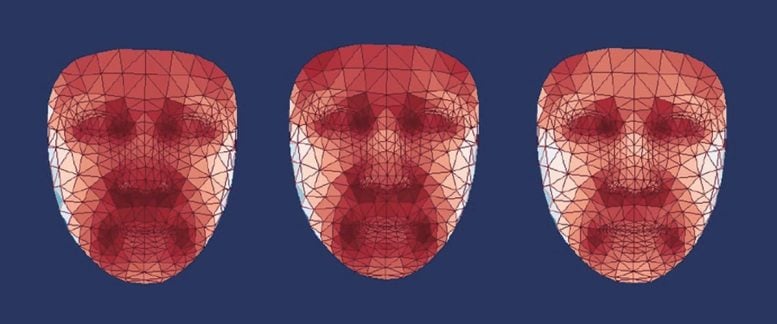Researchers have found that different facial temperatures correlate with chronic illnesses like diabetes and high blood pressure, and these can be detected using AI with thermal cameras.
They highlight the potential of this technology for promoting healthy aging by using thermal facial imaging to predict a person’s health status and biological age. The study also found that regular physical activities like jumping rope can decrease one’s thermal age, suggesting a possible link between exercise and thermal signs of aging.
A colder nose and warmer cheeks may be a telltale sign of rising blood pressure.
Researchers discovered that temperatures in different face regions are associated with various chronic illnesses, such as diabetes and high blood pressure. These temperature differences are not easily perceptible by one’s own touch but can instead be identified using specific AI-derived spatial temperature patterns that require a thermal camera and a data-trained model. The results were published recently in the journal Cell Metabolism. With further research, doctors could one day use this simple and non-invasive approach for early detection of diseases.
Average facial temperatures of three aging-status groups among women 50-60 years old. Credit: Zhengqing Yu and Jing-Dong J Han
Potential of Thermal Facial Imaging
“Aging is a natural process,” says Jing-Dong Jackie Han, the paper’s corresponding author at Peking University in Beijing. “But our tool has the potential to promote healthy aging and help people live disease-free.”
The team had previously used 3D facial structure to predict people’s biological age, which indicates how well the body is aging. Biological age is closely related to the risk of diseases, including cancer and diabetes. They were curious if other features of the face, such as temperature, could also predict aging rate and health status.
Age and Health Indicators Through Thermal Analysis
Han and her colleagues analyzed facial temperatures of more than 2,800 Chinese participants between the ages of 21 and 88. Then, the researchers used the information to train AI models that could predict a person’s thermal age. They identified several key facial regions where the temperatures were significantly related to age and health, including the nose, eyes and cheeks.
The team found the temperature of the nose decreases with age at a rate faster than other parts of the face, meaning people with warmer noses have a younger thermal age. At the same time, temperatures around the eyes tend to increase with age.
The team also found that people with metabolic disorders such as diabetes and fatty liver disease had faster thermal aging. They tended to have higher eye area temperatures than their healthy counterparts of the same age. People with elevated blood pressure also had higher cheek temperatures.
Exploring Thermal Aging and Disease Connections
By analyzing participants’ blood samples, the team revealed that the increase in temperatures around the eyes and cheeks was mainly because of an increase in cellular activities related to inflammation, such as repairing damaged DNAs and fighting infections. The increase in these activities led to a rise in temperatures in certain facial regions.
“The thermal clock is so strongly associated with metabolic diseases that previous facial imaging models were not able to predict these conditions,” Han says.
Thermal Imaging and Physical Activity
Due to this connection, the team set out to test if exercise could influence thermal age. They asked 23 participants to jump rope for at least 800 times daily for two weeks. To the team’s surprise, these participants reduced their thermal age by five years after just two weeks of exercise.
Next, the team wants to explore if they can use thermal facial imaging to predict other diseases, such as sleeping disorders or cardiovascular problems.
“We hope to apply thermal facial imaging in clinical settings, as it holds significant potential for early disease diagnosis and intervention,” Han says.
Reference: “Thermal facial image analyses reveal quantitative hallmarks of aging and metabolic diseases” by Zhengqing Yu, Yong Zhou, Kehang Mao, Bo Pang, Kai Wang, Tang Jin, Haonan Zheng, Haotian Zhai, Yiyang Wang, Xiaohan Xu, Hongxiao Liu, Yi Wang and Jing-Dong J. Han, 2 July 2024, Cell Metabolism.
DOI: 10.1016/j.cmet.2024.05.012
This work was supported by the National Natural Science Foundation of China and the Ministry of Science and Technology of the People’s Republic of China.
News
New study suggests a way to rejuvenate the immune system
Stimulating the liver to produce some of the signals of the thymus can reverse age-related declines in T-cell populations and enhance response to vaccination. As people age, their immune system function declines. T cell [...]
Nerve Damage Can Disrupt Immunity Across the Entire Body
A single nerve injury can quietly reshape the immune system across the entire body. Preclinical research from McGill University suggests that nerve injuries may lead to long-lasting changes in the immune system, and these [...]
Fake Science Is Growing Faster Than Legitimate Research, New Study Warns
New research reveals organized networks linking paper mills, intermediaries, and compromised academic journals Organized scientific fraud is becoming increasingly common, ranging from fabricated research to the buying and selling of authorship and citations, according [...]
Scientists Unlock a New Way to Hear the Brain’s Hidden Language
Scientists can finally hear the brain’s quietest messages—unlocking the hidden code behind how neurons think, decide, and remember. Scientists have created a new protein that can capture the incoming chemical signals received by brain [...]
Does being infected or vaccinated first influence COVID-19 immunity?
A new study analyzing the immune response to COVID-19 in a Catalan cohort of health workers sheds light on an important question: does it matter whether a person was first infected or first vaccinated? [...]
We May Never Know if AI Is Conscious, Says Cambridge Philosopher
As claims about conscious AI grow louder, a Cambridge philosopher argues that we lack the evidence to know whether machines can truly be conscious, let alone morally significant. A philosopher at the University of [...]
AI Helped Scientists Stop a Virus With One Tiny Change
Using AI, researchers identified one tiny molecular interaction that viruses need to infect cells. Disrupting it stopped the virus before infection could begin. Washington State University scientists have uncovered a method to interfere with a key [...]
Deadly Hospital Fungus May Finally Have a Weakness
A deadly, drug-resistant hospital fungus may finally have a weakness—and scientists think they’ve found it. Researchers have identified a genetic process that could open the door to new treatments for a dangerous fungal infection [...]
Fever-Proof Bird Flu Variant Could Fuel the Next Pandemic
Bird flu viruses present a significant risk to humans because they can continue replicating at temperatures higher than a typical fever. Fever is one of the body’s main tools for slowing or stopping viral [...]
What could the future of nanoscience look like?
Society has a lot to thank for nanoscience. From improved health monitoring to reducing the size of electronics, scientists’ ability to delve deeper and better understand chemistry at the nanoscale has opened up numerous [...]
Scientists Melt Cancer’s Hidden “Power Hubs” and Stop Tumor Growth
Researchers discovered that in a rare kidney cancer, RNA builds droplet-like hubs that act as growth control centers inside tumor cells. By engineering a molecular switch to dissolve these hubs, they were able to halt cancer [...]
Platelet-inspired nanoparticles could improve treatment of inflammatory diseases
Scientists have developed platelet-inspired nanoparticles that deliver anti-inflammatory drugs directly to brain-computer interface implants, doubling their effectiveness. Scientists have found a way to improve the performance of brain-computer interface (BCI) electrodes by delivering anti-inflammatory drugs directly [...]
After 150 years, a new chapter in cancer therapy is finally beginning
For decades, researchers have been looking for ways to destroy cancer cells in a targeted manner without further weakening the body. But for many patients whose immune system is severely impaired by chemotherapy or radiation, [...]
Older chemical libraries show promise for fighting resistant strains of COVID-19 virus
SARS‑CoV‑2, the virus that causes COVID-19, continues to mutate, with some newer strains becoming less responsive to current antiviral treatments like Paxlovid. Now, University of California San Diego scientists and an international team of [...]
Lower doses of immunotherapy for skin cancer give better results, study suggests
According to a new study, lower doses of approved immunotherapy for malignant melanoma can give better results against tumors, while reducing side effects. This is reported by researchers at Karolinska Institutet in the Journal of the National [...]
Researchers highlight five pathways through which microplastics can harm the brain
Microplastics could be fueling neurodegenerative diseases like Alzheimer's and Parkinson's, with a new study highlighting five ways microplastics can trigger inflammation and damage in the brain. More than 57 million people live with dementia, [...]






















